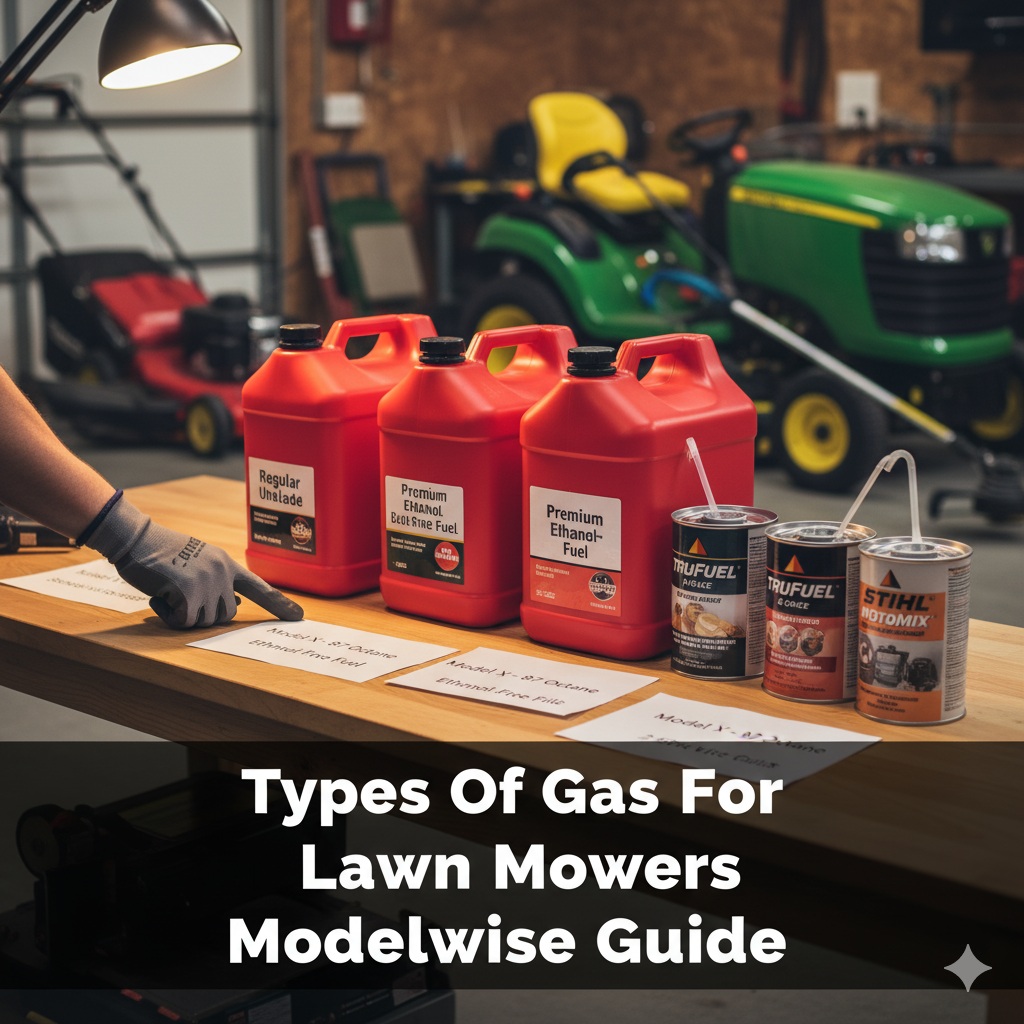
Choosing the right type of gas for lawn mower is one of the simplest yet most important maintenance steps you can take. The correct gasoline ensures easy starts, smooth operation, and long engine life, while the wrong type can cause starting issues, corrosion, and carburetor damage — especially in modern ethanol-blended fuels.
In this comprehensive guide, we’ll cover:
✅ The best gas types for push, riding, and zero-turn mowers
✅ Ethanol-free vs ethanol-blended fuels
✅ Octane ratings and additives
✅ Model-wise recommendations for major brands like Honda, John Deere, Toro, Craftsman, Cub Cadet, and more
⚙️ Why Gas Type Matters for Lawn Mowers
Lawn mower engines are small, air-cooled machines designed for consistent speeds and light loads. They don’t handle poor-quality or old fuel well.
Using the wrong gasoline — such as fuel with too much ethanol or low octane — can cause:
- Hard starting or stalling
- Poor performance and rough idling
- Rust or corrosion in carburetors
- Shortened engine life
🧠 Tip: Lawn mower fuel should be fresh, clean, and preferably ethanol-free.
🧪 Gasoline Basics: What You Should Know
1. Octane Rating
Octane measures a fuel’s resistance to pre-ignition or “knocking.”
For lawn mowers, you typically need 87 octane (regular unleaded). Higher octane doesn’t improve performance — it just costs more.
| Octane | Fuel Type | Use For |
|---|---|---|
| 87 | Regular Unleaded | Most push & riding mowers |
| 89 | Mid-grade | High-compression engines (optional) |
| 91–93 | Premium | Only if manufacturer specifies |
2. Ethanol Content
Ethanol is alcohol blended with gasoline to reduce emissions, but it attracts water and can corrode small engines.
| Fuel Type | Ethanol % | Safe for Mowers? |
|---|---|---|
| E0 (0%) | None | ✅ Ideal choice |
| E10 (10%) | Small amount | ⚠️ Acceptable but not ideal |
| E15 (15%) | Too much ethanol | ❌ Avoid |
| E85 (85%) | High ethanol blend | ❌ Never use |
🧠 Rule of thumb: Use E0 or E10 only — never more than 10% ethanol.
3. Fuel Additives
Fuel stabilizers and detergents improve performance and prevent buildup.
Use additives if:
- Fuel will sit for more than 30 days
- You live in a humid climate (ethanol attracts moisture)
Recommended additives:
- STA-BIL Fuel Stabilizer – Prevents ethanol breakdown
- Sea Foam Motor Treatment – Cleans carburetors
- Star Tron Enzyme Fuel Treatment – Prevents phase separation
⛽ Best Gas for Lawn Mowers (General Rules)
| Type of Mower | Recommended Gas | Notes |
|---|---|---|
| Push Mower | Regular unleaded (87 octane, E0/E10) | Avoid old or stale gas |
| Riding Mower | Regular or mid-grade unleaded (87–89 octane) | Fresh only; avoid >10% ethanol |
| Zero-Turn Mower | Regular unleaded, ethanol-free | For long runtime, consider additives |
| 2-Stroke Engine | 50:1 or 40:1 gas–oil mix | Use small-engine 2-cycle oil |
| 4-Stroke Engine | Straight gasoline | Check oil separately |
⚠️ Always refer to your owner’s manual for exact requirements.
🧩 Model-Wise Fuel Recommendations
Here’s a detailed guide for major mower brands and their preferred gas types.
🟥 Honda Lawn Mowers (HRN, HRX, HRS, HRR, GCV Engines)
- Recommended Gas: Regular unleaded, 87+ octane, E0–E10
- Avoid: Gas older than 30 days, E15 or E85 fuels
- Notes: Use ethanol-free gas when available; add stabilizer if storing fuel.
🧠 Tip: Honda’s GCV engines are sensitive to ethanol — run dry after each mowing season.
🟩 John Deere Riding & Zero-Turn Mowers
- Recommended Gas: 87–89 octane, E0 preferred
- Avoid: Gasoline with more than 10% ethanol
- Notes: Mid-grade (89) helps reduce knocking in V-Twin engines.
- Additives: Use STA-BIL if storing mower for winter.
✅ Works best with non-oxygenated “Recreation Fuel” sold at premium stations.
🟥 Toro Lawn Mowers (Recycler, TimeMaster, TimeCutter)
- Recommended Gas: 87 octane, E0 or E10
- Avoid: E15 and E85 fuels
- Notes: Toro recommends fuel less than 30 days old for best starting.
- Optional: 91 octane for hotter climates or high-altitude operation.
⚙️ If mower stalls or surges, drain old gas and refill with fresh ethanol-free fuel.
🟧 Craftsman Lawn Mowers (Walk-Behind & Riding)
- Recommended Gas: Regular unleaded, 87 octane, E0–E10
- Avoid: High ethanol fuels; water-contaminated storage gas
- Notes: For 2-cycle models, mix 40:1 gas-to-oil using Craftsman 2-stroke oil.
🧰 Briggs & Stratton engines on Craftsman mowers prefer fresh E0 gas.
🟨 Cub Cadet Lawn Mowers (XT1, XT2, Ultima, ZT Series)
- Recommended Gas: Regular unleaded, 87–89 octane
- Avoid: E15/E85
- Notes: V-Twin Kawasaki engines perform best on E0 mid-grade fuels.
- Additive: Use STA-BIL or Sea Foam if stored over 60 days.
💡 Tip: Drain tank after each season to prevent varnish buildup.
🟧 Husqvarna Lawn Mowers (YTH, LC, and Automower Series)
- Recommended Gas: Regular unleaded, 87 octane, E0/E10
- Avoid: High-ethanol blends
- Notes: Use ethanol-free premium fuel for 2-stroke handheld mowers.
- Special Case: Robotic Automower is battery-powered — no fuel required.
⚙️ 4-stroke Husqvarna engines (like YTH models) are compatible with 10% ethanol max.
🟦 Briggs & Stratton Engines (Used in Many Brands)
- Recommended Gas: 87 octane minimum
- Avoid: Gas with >10% ethanol
- Notes: Replace gas every 30 days for best ignition.
- Additive: Sea Foam recommended for carburetor longevity.
🧠 B&S explicitly states: No E15 or E85. Short shelf life gas causes 80% of carb issues.
🟨 Kawasaki Engines (Scag, Exmark, Gravely, John Deere Commercial)
- Recommended Gas: 87–89 octane, E0 preferred
- Avoid: Ethanol-rich gas — leads to carb and filter issues.
- Notes: Use 15W-50 synthetic oil + non-ethanol gas for best performance.
- Fuel Capacity Tip: Always store with stabilizer during off-season.
🧰 Ideal fuel: “Rec Fuel” or “Recreation Gasoline” available at marine or power equipment stores.
🟩 EGO, Greenworks, and Bosch Electric Mowers
- Fuel Type: ❌ None (battery-powered)
- Notes: Use only OEM batteries and chargers.
- Maintenance Tip: Clean terminals; store batteries indoors during winter.
⚡ Electric mowers eliminate all fuel problems — no ethanol or gas maintenance needed.
🟥 Scag, Exmark, and Gravely Zero-Turn Mowers
- Recommended Gas: 87–89 octane, ethanol-free for heavy-duty commercial use
- Avoid: Gas older than 30 days
- Notes: Commercial mowers run hotter; always keep tanks clean and sealed.
⚙️ For models with Kawasaki FX/FR engines, use E0 or mid-grade fuel only.
🧯 How to Store Gasoline Properly
Even the right gas will go bad if stored incorrectly.
✅ Proper Fuel Storage Rules:
- Use approved red gas containers (never water bottles).
- Store fuel in a cool, dry, ventilated area away from heat.
- Keep containers tightly sealed to prevent moisture absorption.
- Add fuel stabilizer if storing more than 30 days.
- Rotate stored gas every 60–90 days.
🧠 Ethanol-free gas lasts 6–12 months; E10 fuel lasts only 30–60 days.
🧰 How to Drain Old Gas Before Refilling
Before refilling with fresh gas:
- Disconnect spark plug.
- Use a siphon or remove fuel line to drain old gas completely.
- Clean carburetor bowl if necessary.
- Add fresh fuel + stabilizer.
- Run mower 5–10 minutes to circulate.
🔧 Refer to your manual if the mower won’t start after refueling — old gas may have clogged the carburetor.
🧾 Fuel-Related Maintenance Tips
✅ Check and clean carburetor once a season.
✅ Replace fuel filter every 50–100 hours of use.
✅ Use a funnel with screen to avoid debris entering tank.
✅ Never mix oil and gas in 4-stroke engines.
✅ Run mower dry before long-term storage.
🛠️ Quick Model-Fuel Compatibility Chart
| Brand / Model | Gas Type | Octane Rating | Ethanol Limit | Additives? |
|---|---|---|---|---|
| Honda HRX / HRN | Regular (E0/E10) | 87+ | 10% max | STA-BIL / Sea Foam |
| John Deere ZTrak / X300 | Regular / Mid | 87–89 | 10% max | STA-BIL |
| Toro Recycler / TimeCutter | Regular | 87 | 10% max | Fuel stabilizer |
| Craftsman (B&S Engine) | Regular | 87 | 10% max | Sea Foam |
| Cub Cadet XT1 / XT2 | Regular / Mid | 87–89 | 10% max | STA-BIL |
| Husqvarna YTH | Regular | 87 | 10% max | Sea Foam |
| Briggs & Stratton | Regular | 87 | 10% max | Stabilizer |
| Kawasaki FX / FR | Mid-grade | 89 | 10% max | Fuel conditioner |
| Scag / Exmark | Regular / Mid | 87–89 | 10% max | Sea Foam |
| EGO / Greenworks / Bosch | Electric | — | — | — |
🧠 Common Questions About Lawn Mower Gas
1. Can I use car gas in my lawn mower?
Yes, but it must be unleaded regular (87 octane) with no more than 10% ethanol.
2. Is premium gas better?
No — higher octane doesn’t improve performance unless recommended by the manufacturer.
3. Can I use old gas if I add stabilizer?
Only if it’s less than 60 days old. Old, oxidized fuel can still harm the carburetor.
4. Why does ethanol cause problems?
Ethanol attracts water, leading to phase separation, corrosion, and varnish buildup.
5. Can I mix new gas with old gas?
Not recommended — always drain the tank before refilling.
6. Where can I buy ethanol-free gas?
Look for “Recreation Fuel” or marine gas stations, or check websites like pure-gas.org.
✅ Summary: Best Gas for Lawn Mowers
| Fuel Feature | Ideal Specification |
|---|---|
| Octane rating | 87 (regular unleaded) |
| Ethanol content | 0–10% max |
| Fuel age | Under 30 days old |
| Additives | Fuel stabilizer for storage |
| Storage | Cool, sealed container |
Bottom Line:
Use fresh, ethanol-free 87 octane gasoline for all 4-stroke lawn mowers.
If using ethanol blends, add a stabilizer and never exceed 10% ethanol.
For 2-stroke engines, always mix with proper oil as directed.
📚 References
- Fuel For Lawn Mower Use? Husqvarna: Fuel Recommendations for Small Engines
- Reddit: Gasoline Recommendations for Riding Mowers
- Toro Lawn Care: Proper Fuel and Storage Tips
- Kawasaki Engines USA: Best Gas for Lawn Mowers and Small-Engine Power Equipment

I’m David man behind Lawn Mowerly; I’ve been dealing with lawnmowers and Tractors with my father since I was a kid. I know every make and model and what each one is capable of and love helping people find the perfect equipment for their needs.
